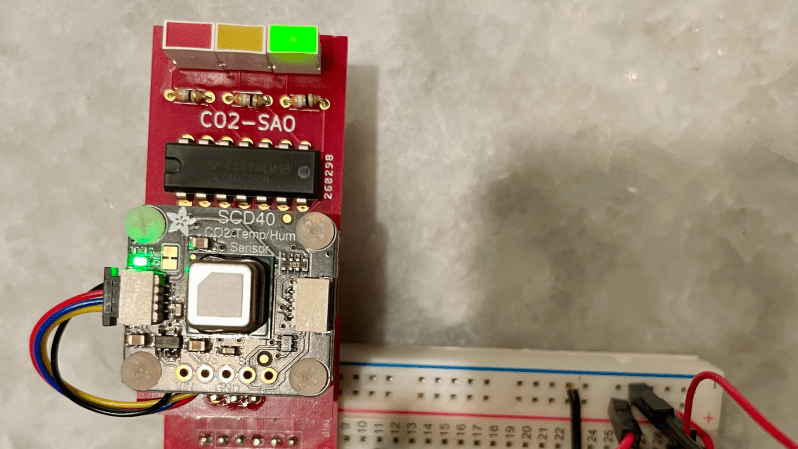[David Bryant] clearly has an awareness of the impact of an excess concentration of CO2 in the local environment and has designed an SAO board to add a CO2 traffic light indicator to one of the spare slots on the official Hackaday Supercon 2024 badge.
The part used is the Sensirion SCD40 ‘true’ CO2 sensor, sitting atop an Adafruit rider board. [David] got a leg up on development by creating a simple SAO breakout board, which could have either the male and female connectors fitted, as required. Next, he successfully guessed that the badge would be based around the RP2040 running MicroPython and hooked up an Adafruit Feather RP2040 board to get started on some software to drive the thing. This made hooking up to the official badge an easy job. Since the SAO has only two GPIOs, [David] needed to decode these to drive the three LEDs. There are a few ways to avoid this, but he wanted to relive his earlier EE college years and do it the direct way using a pair of 74HC00 quad NAND gate chips.
We’ve seen a few CO2 monitors over the years. This sleek little unit is based around the Seeeduino XIAO module and uses an LED ring as an indicator. Proper CO2 monitors can be a little pricey, and there are fakes out there. Finally, CO2 is not the only household pollutant; check out this project.
















There’s an ‘i’ missing in Sensirion :)
Good spot! I’ve been thinking I need an eye test lately, and this is yet another data point.
“Since the SAO has only two GPIOs, [David] needed to decode these to drive the three LEDs. ”
What does that mean? 2GPIO constitute 4 possible states, enough for three LED’s. Right?
An LED doesn’t magically know it needs to be turned on when the 2 bits are set to it’s state value. Something needs to decode the binary value into 4 wires where only one is high at any particular time.
You still need to decode the binary signals to individual LEDs, otherwise one state is just both LEDs on instead of 3rd LED on.
I’ve been meaning to design and build an indoor air quality monitoring node which i will then place in the various corners of my room and then play around with the ventilation. Alas i haven’t been able to find a decent sensor which was also inexpensive.
Most cheaper CO2 sensors are just VOC sensors and misrepresent themselves as CO2 sensors
$45 for the sensor, I guess Hackaday won’t be passing them out like candy!
B^)
Thanks for the post and comments! [Eric Klein] and I have been prototyping a variety of CO2 and air quality monitoring devices, some wearable and some not, some with a display and some not, some networked and some not, etc., and as this was my first Supercon (thanks to [Eric]) it seemed like a great time to try my first real “production” PCB design and SAO.
The two wires -> three LEDs approach is an homage to how I learned digital electronics in college fifty years ago when you built using combinations of individual logic gates and the occasional flip-flop. (Karnaugh maps, anyone?). CO2-SAO uses two 7400 quad nand gate ICs to get the job done, and with a Gray code Easter egg in the process.
The $45 price for the SCD40 breakout we used at the show definitely limited SAO trading and is overkill for this application, but [Eric] has been sourcing the sensors separately and we demonstrated at Supercon a build that works with a $17 part. Given I2C (and Qwiic) you could spend less on an approximating CO2 sensor but we wanted true readings.
All the details, PCB designs, code, etc. for CO2-SAO are on GitHub: https://github.com/disquisitioner/Supercon-SAO. See you next year!
The endless “SAO” crap is getting really boring.
But what is SAO? Is it an acronym for something? Why isn’t this mentioned anywhere?
You must be new here….
Oh! [Hans], meet [Oscar Goldman] (above)
To give you an actually useful reply: It’s the “Simple Add-On” or “Supercon Add-On” for the hackable conference badges for Hackaday’s Superconference-8 that was in Pasadena last week.